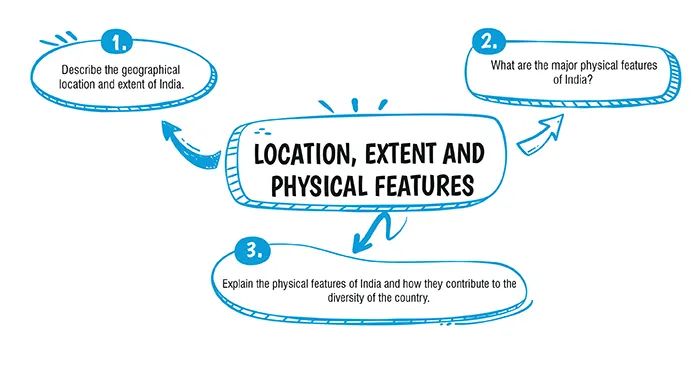Table of Contents

Ans. B) Tropic of Cancer
Explanation:
The Tropic of Cancer (23°30'N) passes almost through the middle of India, significantly influencing its climate and agricultural patterns.
Ans. D) Himalayas
Explanation:
The Himalayan mountain ranges form the northern frontier of India, serving as a natural barrier and influencing the climate and ecology of the region.
Explanation:
India is located in the southern part of Asia, extending from latitudes 8°4'N to 37°6'N and longitudes 68°7'E to 97°25'E. It's spread over an area of about 3.28 million sq km, making it the seventh-largest country in the world. India shares its land borders with Pakistan, China, Nepal, Bhutan, Bangladesh, and Myanmar, and is surrounded by the Indian Ocean on the south, the Arabian Sea on the west, and the Bay of Bengal on the east.
Explanation:
India's physical features are diverse and rich, comprising the Himalayas in the north, the Northern Plains, the Indian Desert, the Peninsular Plateau, the Coastal Plains, and the Islands. The Himalayas, a vast mountain range, acts as a natural barrier and influences the climate of India. The Northern Plains, formed by the rivers Indus, Ganges, and Brahmaputra, are known for their fertile lands. The Peninsular Plateau is a region of stable landmass characterised by undulating terrain, rich mineral resources, and a variety of flora and fauna.
Explanation:
India's physical features are diverse and can be broadly categorised into the following:
These physical features contribute to India's climatic, ecological, and cultural diversity. The variation in terrain and climate across the country supports a wide range of agricultural activities, ecosystems, and lifestyles, making India one of the most diverse nations in the world.
Download Mind Map of this chapter
Download NowWant to Practice Mock Tests of this chapter
Practice NowDownload Important Questions of this chapter
Download Now| Chapter No. | Chapter Name |
|---|---|
| Chapter 1 | Map Study: Interpretation of Topographical Maps |
| Chapter 2 | Map of India |
| Chapter 3 | Location, Extent and Physical features |
| Chapter 4 | Climate of India |
| Chapter 5 | Soil Resources |
| Chapter 6 | Natural Vegetation of India |
| Chapter 7 | Water Resources |
| Chapter 8 | Mineral and Energy Resources |
| Chapter 9 | Agriculture In India |
| Chapter 10 | Industries in India: Agro Based |
| Chapter 11 | Industries in India: Mineral Based |
| Chapter 12 | Transport in India |
| Chapter 13 | Waste Generation and Management |
CBSE Important Questions Class 10
ICSE Important Questions Class 10
CBSE Important Questions Class 10
ICSE Important Questions Class 10